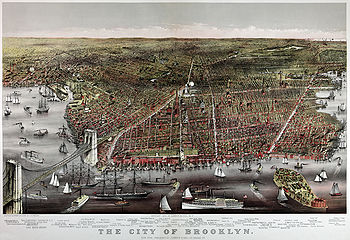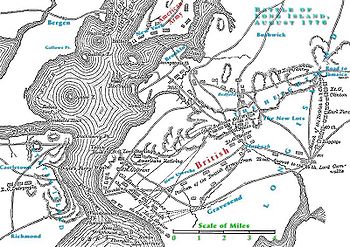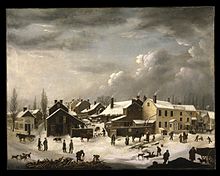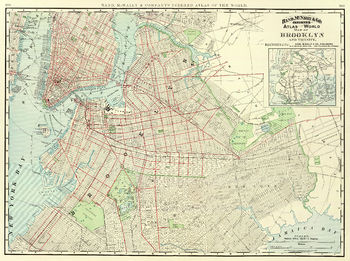- History of Brooklyn
-
 Currier and Ives print of Brooklyn, 1879.
Currier and Ives print of Brooklyn, 1879.
The history of Brooklyn, a present-day borough of New York City, spans more than 350 years. The settlement began in the 17th century as the small Dutch-founded town of "Breuckelen" on the East River shore of Long Island, grew to be a sizable city in the 19th century, and was consolidated in 1898 with the New York City (then confined to Manhattan and part of The Bronx), the remaining rural areas of Kings County, and the largely rural areas of Queens and Staten Island, to form the modern New York City.
Contents
Six Dutch towns
New Netherland series Exploration Fortifications: • Fort Nassau (North)
• Fort Orange
• Fort Nassau (South)
• Fort Goede Hoop
• De Wal
• Fort Wilhelmus
• Fort Beversreede
• Fort Nya Korsholm
• De Rondout
Settlements: • Rensselaerswyck
• Beverwijck
• Wiltwyck
• Bergen
• Pavonia
• Vriessendael
• Achter Col
• Heemstede
• Rustdorp
• Midwout
• Boswyck
• Swaanendael
The Patroon System Directors of New Netherland: Cornelius Jacobsen May (1620-25)
Willem Verhulst (1625-26)
Peter Minuit (1626-32)
Sebastiaen Jansen Krol (1632-33)
Wouter van Twiller (1633-38)
Willem Kieft (1638-47)
Peter Stuyvesant (1647-64)
People of New Netherland Flushing Remonstrance The Dutch were the first Europeans to settle the area on the western edge of Long Island, which was then largely inhabited by the Lenape, a Native American people who are often referred to in contemporary colonial documents by a variation of the place name "Canarsie." The "Breuckelen" settlement, named after Breukelen in the Netherlands, was part of New Netherland, and the Dutch West India Company lost little time in chartering the six original parishes (listed here first by their later, more common English names):[1]
- Gravesend: in 1645, settled under Dutch patent by English followers of the Anabaptist, Lady Deborah Moody, after the town 's-Gravenzande, Netherlands
- Brooklyn: as "Breuckelen" in 1646, after the town now spelled Breukelen, Netherlands
- Flatlands: as "New Amersfoort" in 1647
- Flatbush: as "Midwout" in 1652
- New Utrecht: in 1657, after the city of Utrecht, Netherlands
- Bushwick: as "Boswijck" in 1661
Many incidents and documents relating to this period are in Gabriel Furman's early (1824) compilation. [2]
The capital of the colony, New Amsterdam across the river, obtained its charter later than Brooklyn did, in 1653.
Six townships in an English province
What is today Brooklyn left Dutch hands after the final English conquest of New Netherland in 1664, in a prelude to the Second Anglo–Dutch War. New Netherland was taken in a naval action, and the conquerors renamed their prize in honor of the overall English naval commander, James, Duke of York; Brooklyn became a part of the Province of New York.
The English organized the six old Dutch towns of southwestern Long Island as Kings County on November 1, 1683,[3] one of twelve counties then established in New York. This tract of land was recognized as a political entity for the first time, and the municipal groundwork was laid for a later expansive idea of Brooklyn identity.
Lacking the patroon and tenant farmer system of the Hudson Valley, this agricultural county came to have one of the highest percentages of slavery among the population in the Thirteen Colonies.[citation needed]
Revolutionary War
 The Battle of Long Island was fought across Kings County
The Battle of Long Island was fought across Kings County
On August 27, 1776, the Battle of Long Island (also known as the Battle of Brooklyn) was the first major engagement fought in the American Revolutionary War after independence was declared, and the largest of the entire conflict. British troops forced Continental Army troops under George Washington off the heights near the modern sites of Green-Wood Cemetery, Prospect Park, and Grand Army Plaza. Washington, viewing particularly fierce fighting at the Gowanus Creek from his vantage point atop a hill near the west end of present-day Atlantic Avenue, was famously reported to have emotionally exclaimed: "What brave men I must this day lose!" The fortified American positions at Brooklyn Heights consequently became untenable and were evacuated a few days later, leaving the British in control of New York Harbor. While Washington's defeat on the battlefield cast early doubts on his ability as commander, the subsequent tactical withdrawal of all his troops and supplies across the East River in a single night is seen by historians as one of his most brilliant triumphs.[4]
The surrounding region was controlled by the British for the duration of the war, as New York City was soon occupied and became their military and political base of operations in North America for the remainder of the conflict. The British generally enjoyed a dominant Loyalist sentiment from the remaining residents in Kings County who did not evacuate, though the region was also the center of the fledgling — and largely successful — American intelligence network, headed by Washington himself. The British set up a system of notorious prison ships off the coast of Brooklyn in Wallabout Bay, where more American patriots died of intentional neglect than died in combat on all the battlefields of the American Revolutionary War, combined. The Treaty of Paris in 1783 resulted, in part, in the evacuation of the British from New York City, celebrated by residents into the 20th century.
Urbanization
The first half of the 19th century saw the beginning of the development of urban areas on the economically strategic East River shore of Kings County, facing the adolescent City of New York confined to Manhattan Island. The New York Navy Yard operated in Wallabout Bay (border between Brooklyn and Williamsburgh) for the entire 19th century and two thirds of the 20th century.
The first center of urbanization sprang up in the Town of Brooklyn, directly across from Lower Manhattan, which saw the incorporation of the Village of Brooklyn in 1816. Reliable steam ferry service across the East River to Fulton Landing converted Brooklyn Heights into a commuter town for Wall Street. Ferry Road to Jamaica Pass became Fulton Street to East New York. Town and Village were combined to form the first, kernel incarnation of the City of Brooklyn in 1834.
In parallel development, the Town of Bushwick, a little farther up the river, saw the incorporation of the Village of Williamsburgh in 1827, which separated as the Town of Williamsburgh in 1840, only to form the short-lived City of Williamsburgh in 1851. Industrial deconcentration in mid-century was bringing shipbuilding and other manufacturing to the northern part of the county. Each of the two cities and six towns in Kings County remained independent municipalities, and purposely created non-aligning street grids with different naming systems.
But the East River shore was growing too fast for the three-year-old infant City of Williamsburgh, which, along with its Town of Bushwick hinterland, was subsumed within a greater City of Brooklyn in 1854.
Agitation against Southern slavery was stronger in Brooklyn than in New York, and under Republican leadership the city was fervent in the Union cause in the Civil War. A great victory arch at Grand Army Plaza was built after the war, and a smaller monument was built downtown to Abolitionist leader Henry Ward Beecher, pastor at Brooklyn's Plymouth Church.
Civil War
Fervent in the Union cause, the city of Brooklyn played a major role in supplying troops and material for the American Civil War. The most well known regiment to be sent off to war from the city was the 14th Brooklyn "Red Legged Devils". They fought from 1861 to 1864 and wore red the entire war. They were the only Regiment named after a city, and President Lincoln called them into service personally, making them part of a handful of 3 year enlisted soldiers in April 1861. Unlike other regiments during the American Civil War, the 14th wore a uniform inspired by that of the French Chasseurs, a light infantry used for quick assaults on the enemy.
As both a seaport and a manufacturing center, Brooklyn was well prepared to play to the Union's strengths in shipping and manufacturing. The two combined in shipbuilding; the ironclad Monitor was built in Brooklyn.
Twin city
Taking a thirty-year break from municipal expansionism, this well-situated coastal city established itself as the third-most-populous American city for much of the 19th century. Brooklyn is referred to as a twin city of New York in the 1883 poem, "The New Colossus" by Emma Lazarus, which appears on a plaque inside the Statue of Liberty. The poem calls New York Harbor, "The air-bridged harbor that twin cities frame." As a twin city to New York, it played a role in national affairs that was later overshadowed by its century-old submergence into its old partner and rival.
Economic growth continued, propelled by immigration and industrialization. The waterfront from Gowanus Bay to Greenpoint was developed with piers and factories. Industrial access to the waterfront was improved by the Gowanus Canal and the canalized Newtown Creek. The USS Monitor was only the most famous product of the large and growing shipbuilding industry of Williamsburg. After the Civil War, trolley lines and other transport brought urban sprawl beyond Prospect Park and into the center of the county.
The rapidly growing population needed more water, so the City built centralized waterworks including the Ridgewood Reservoir. The municipal Police Department, however, was abolished in 1854 in favor of a Metropolitan force covering also New York and Westchester Counties. In 1865 the Brooklyn Fire Department (BFD) also gave way to the new Metropolitan Fire District.
Throughout this period the peripheral towns of Kings County, far from Manhattan and even from urban Brooklyn, maintained their rustic independence. The only municipal change seen was the secession of the eastern section of the Town of Flatbush as the Town of New Lots in 1852. The building of rail links such as the Brighton Beach Line in 1878 heralded the end of this isolation.
Sports became big business, and the Brooklyn Bridegrooms played professional baseball at Washington Park in the convenient suburb of Park Slope and elsewhere. Early in the next Century they brought their new name of Brooklyn Dodgers to Ebbets Field, beyond Prospect Park. Racetracks, amusement parks and beach resorts opened in Brighton Beach, Coney Island and elsewhere in the southern part of the county.
Toward the end of the 19th century, the City of Brooklyn experienced its final, explosive growth spurt. Railroads and industrialization spread to Bay Ridge and Sunset Park. In the space of a decade, the city annexed the Town of New Lots in 1886, the Town of Flatbush, the Town of Gravesend, the Town of New Utrecht in 1894, and the Town of Flatlands in 1896. Brooklyn had reached its natural municipal boundaries at the ends of Kings County.
Mayors of the City of Brooklyn[5] Mayor Party Start year End year George Hall Democratic-Republican 1834 Jonathan Trotter Democrat 1835 1836 Jeremiah Johnson Whig 1837 1838 Cyrus P. Smith 1839 1841 Henry C. Murphy Democrat 1842 Joseph Sprague 1843 1844 Thomas G. Talmage 1845 Francis B. Stryker Whig 1846 1848 Edward Copland 1849 Samuel Smith Democrat 1850 Conklin Brush Whig 1851 1852 Edward A. Lambert Democrat 1853 1854 George Hall 1855 1856 Samuel S. Powell Democrat 1857 1860 Martin Kalbfleisch 1861 1863 Alfred M. Wood Republican 1864 1865 Samuel Rooth 1866 1867 Martin Kalbfleisch Democrat 1868 1871 Samuel S. Powell 1872 1873 John W. Hunter 1874 1875 Frederick A. Schroeder Republican 1876 1877 James Howell Democrat 1878 1881 Seth Low Republican 1882 1885 Daniel D. Whitney Democrat 1886 1887 Alfred C. Chapin 1888 1891 David A. Boody 1892 1893 Charles A. Schieren Republican 1894 1895 Frederick W. Wurster 1896 1898 New York borough
Further information: History of New York City (1898-1945)In 1883, the Brooklyn Bridge was completed, transportation to Manhattan was no longer by water only, and the City of Brooklyn's ties to the City of New York were strengthened. The question became whether Brooklyn was prepared to engage in the still-grander process of consolidation then developing throughout the region, whether to join with the county of New York, the county of Richmond and the western portion of Queens County to form the five boroughs of a united City of New York. Andrew Haskell Green and other progressives said Yes, and eventually they prevailed against the Daily Eagle and other conservative forces. In 1894, residents of Brooklyn and the other counties voted by a slight majority to merge, effective in 1898.[6]
Kings County retained its status as one of New York State's counties, but the loss of Brooklyn's separate identity as a city was met with consternation by some residents at the time. The merger was called the "Great Mistake of 1898" by many newspapers of the day, and the phrase still denotes Brooklyn pride among old-time Brooklynites.[citation needed]
See also
- History of New York City
- National Register of Historic Places listings in Kings County, New York
- List of former municipalities in New York City
- Thomas Jones (historian)
- Fort Brooklyn
Neighborhood histories
- Bushwick
- Canarsie
- Coney Island
- Crown Heights
- East Williamsburg
- Gravesend
- Greenpoint
- Park Slope
- Williamsburg
Notes
- ^ Brooklyn Daily Eagle Map of six townships
- ^ Notes Geographical and Historical, relating to the Town of Brooklyn, in Kings County on Long-Island.
- ^ N.Y. Col. Laws, ch4/1:122
- ^ McCullough, David. 1776. Simon & Schuster. May 24, 2005. [ISBN 978-0743226714]
- ^ The Encyclopedia of New York City; (P. 149 3rd Column.)
- ^ The 100 Year Anniversary of the Consolidation of the 5 Boroughs into New York City, New York City, http://www.nyc.gov/html/nyc100/html/classroom/hist_info/100aniv.html, retrieved 2008-01-31
References
 Chisholm, Hugh, ed (1911). "Brooklyn". Encyclopædia Britannica (11th ed.). Cambridge University Press.
Chisholm, Hugh, ed (1911). "Brooklyn". Encyclopædia Britannica (11th ed.). Cambridge University Press.
External links
- The Brooklyn Daily Eagle Online, 1841-1902 (from the Brooklyn Public Library)
- Crossing Brooklyn Ferry by Walt Whitman
- Historic Maps of Brooklyn hosted by the David Rumsey Historical Map Collection
- The Brooklynites a photojournalism project about Brooklyn residents
- See historic houses on amNY.com
- Notes Geographical and Historical, relating to the Town of Brooklyn, in Kings County on Long-Island. (1824) An Online Electronic Text Edition. by Gabriel Furman
- May 4, 1894). "Becoming Wards One By One" The Brooklyn Daily Eagle Page 12
- Society of Old Brooklynites
Categories:- Brooklyn
- New Netherland
- History of New York City
- Lists of mayors of places in the United States
Wikimedia Foundation. 2010.






